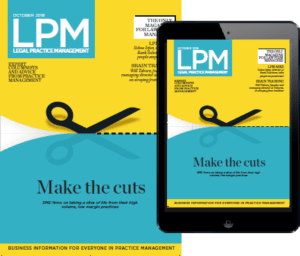
What’s in store for SME law firms in 2025?
From technological advances to regulatory and cash pressures, Eaton-Evans & Morris CEO Sarah Charlton sums up the forces most impacting the UK SME legal market in the year ahead
As we clear away the Christmas party poppers and start to concentrate on the year ahead, I am sure most SME legal business leaders will have a mixture of excitement and dread.
I feel 2024 brought with it technological advances not just in the legal sector but also with service providers supporting the sector. This is likely to have been one of the catalysts that captured the appetite of SME law firms, which have previously been slow at adopting technology. This shift to a ‘digital first’ in mindset over the course of 2024 is likely to create more affordable products from service providers that are better tailored to the SME legal market. This is exciting in itself!
In 2024 we also saw AI have a presence at most conferences, which reinforced the view of many industry leaders that AI isn’t going to go away anytime soon.
For those of you, like me, who have been working in the legal sector for three or four decades, you will recall a handful of key milestones that have enabled a proportion of firms to create a very wide competitive advantage; typewriters to computers, manual accounts to computerised, adoption of websites to name but a few. Firms that fell behind simply closed as the gap became too big.
I believe AI will be one of those milestones. Those firms that were early adopters of AI are likely to place themselves in pole position for widening the gap between their competitors.
What is increasingly exciting is the wide variety of opportunities that AI presents from assisting with source of wealth/funds checks, filtering key legal information from important documents, or creating social media posts. I am excited to see which firms and suppliers do this well in 2025.
Capitalising on opportunities tends to cost money. SME firms don’t often attract external investment in the same way larger firms do, so managing working capital and partner succession is often a juggling act. Partners who are close to retirement may not wish to tie their money up in medium to long term technology investments.
SME leaders are also grappling with economic, legislative and regulatory challenges that are likely to emerge in 2025.
I spent some of Christmas flexing my budget to accommodate both the increase in employer national insurance and the national minimum wage. Suppliers have also been putting their prices up to absorb these increases. The combined result of this is one where SME firms are going to have to significantly increase their prices. However, this is in a market where we are seeing an increase in price sensitive clients, many of whom have been coming off their fixed rate mortgages.
There is also a real feeling that the Solicitors Regulation Authority (SRA) might have something to prove during 2025 in the wake of The Legal Services Board decision to review their dealing of Axiom Ince.
Finally, a new government often brings with it new legislation that has been promised in their manifesto, so we also have to be prepared for this.
And here was me hoping 2025 would be a quiet one!

Setting the right price
Pricing models need to take into consideration law firm needs as well as clients’ individual circumstances, says Sarah Charlton, chief executive officer at Eaton Evans & Morris.
The word ‘pricing’ can invoke many thoughts – solicitors undervaluing their worth, costs information, fixed fees, hourly rates, legal aid, CFA’s, bundled or unbundled. For the accountants hidden among you, perhaps thoughts jumped to realisation and utilisation rates? However, I would be intrigued to know how many of you immediately thought of value pricing?
The concept of value pricing feels like it is the new kid on the block but is it really that new? Or has it been around for a long time, just not in the regulated sector? Estate agents are always placing a value on a property – that doesn’t necessarily mean it is worth that amount of money. It is merely a case that someone might be willing to pay that value for it. You may be content to pay over the market rate if it is close to a school/college or family member, if it is an adjoining piece of land or close to where you work. With all this in mind, we are often prepared to pay over the odds for something that we really want or we feel that we need.
So how does this map over into the legal sector? I think it is fair to say that pricing probably doesn’t receive enough attention across the profession. As an accountant and a compliance specialist, I am always looking to be as commercial as possible within the realms of compliance and the spirit of the law. However, value pricing does leave me very uneasy.
Why do I feel so uneasy? Is it because of the regulator? The Legal Ombudsmen? The courts? Culture? Or possibly all of them!
Having read the SRA’s guidance around the transparency rules it is clear to me that it is not their intention to specify what pricing models you should use, or the prices you should charge. However, it is common for consumers (a word you either love or hate!) to procure legal services at a distressing time in their life – is this not a form of vulnerability? I am always advocating that the SRA Accounts Rules should never be read in isolation as there are much wider considerations to be taken into account such as VAT, Solicitors Act 1974 etc. With that in mind, perhaps the regulator doesn’t need to interfere with pricing when Rule 1.2 of the Code of Conduct for Firms requires you not to ‘abuse your position by taking unfair advantage of clients’. The SRA also promote this to consumers by advising them that they can expect to ‘receive advice and services from advisors who put your interests first’. I would be nervous about a team applying value pricing consistently within the confines of regulation and how I might spot someone going ‘off-piste’.
The Legal Ombudsmen deal with dissatisfied legal consumers (subject to eligibility). Assuming you have been clear, transparent and accurate about the value that is being placed on the piece of legal work that you are completing – it might be fair to say that the risk of recourse would be the same as any other, more common, pricing models.
There appears to be an emerging trend of consumers exercising their right to challenge legal costs through the courts. This sits in the backdrop of what feels to be a lack of tolerance by costs judges for overly inflated legal bills. This is resonated by a recent report that was commissioned and released during this summer by the Costs Lawyer Standards Board (CLSB) to ascertain how costs lawyers might be able to reduce the costs of legal services. How will costs lawyers, costs judges adapt to value pricing?
Finally, the term ‘culture’ has become a bit of a buzz word, with an increasing number of law firms actively looking to create a positive and inclusive atmosphere. Could culture be aligned to value pricing or are staff going to feel conflicted with pricing the value of what might be a lifeline, light at the end of the tunnel or a way out of an incredibly difficult situation? The question remains of how to evaluate a fair price for both sides.
Most Popular

Where are the challenges for SME law firm leadership changing?

The leading annual picture of SME law firms' changing strategic priorities
TA Triumph-Adler provides tailored support to meet compliance requirements

Law firms undertaking identity verification checks must register as an ASCP

Robust onboarding processes are fundamental to effective risk prevention

Osprey Approach's webinar explores the benefits of a digital-first approach

Switching bank accounts – a legal cashier’s tale
Sarah Charlton, chief executive officer at BlueSky Legal Finance Solutions, explains how law firms can switch bank accounts in the smoothest manner possible.
I think it’s fair to say that a lot has been done within the banking industry over recent years to make it much easier for businesses to physical switch current bank accounts. This is a ‘good news story’ for law firms who want the flexibility to move, which has become more common in recent years not just because of pricing but also the more dynamic, ethical or environmental banking institutions that are now on the market.
Unfortunately, it is often a different story when it comes to aligning your accounting records with the new bank accounts. Good planning, adequate accounting software and technical cashiering knowledge can influence the success or failure of implementing a new bank account.
The first step to switching a bank account is to create a new cashbook (bank account) within your accounting software. Ensure that you have received your cheque books and paying-in books, and that any electronic banking software platforms have been activated.
The second step would be to double check the physical bank statements. If it is a client account, the word ‘client’ must be in full (it cannot be abbreviated)- see SRA AR 2019 3.2(b). Also check the name on the client account exactly matches the name that the SRA have authorised – see SRA AR 2019 3.2(a). This may be different to your trading name – you can go onto the Law Society’s ‘find a solicitor’ guide to double check the precise name that has been authorised by the SRA. You should set up user profiles on any online banking platform and make sure the relevant members of staff have appropriate access (inputter and authoriser could be different) and dual authorisations (perhaps over a set value), and that other safeguards are all in place and have been appropriately tested.
You then have two approaches available – a complete switch on an agreed day (I would recommend the 1st of the month) to the new bank account. Standing orders, direct debits and unpaid cheques or outstanding lodgements will all be redirected to the new bank account. Alternatively, you may wish to run the two bank accounts in tandem, using your new bank account for all new matters.
I would recommend you consider reviewing all unpaid cheques that are over three months old, unless they are payable to a government organisation such as HMCTS or HMRC. I would look to investigate the remaining cheques, starting with the highest value first. Many law firms operate two client accounts to provide a contingency for any serious banking failures, as have been seen in previous years. You therefore may wish to continue to keep your original bank account open for this purpose.
Before you start using your new bank account, change your ‘default’ cashbook on your accounting software to the new cashbook/s. Otherwise, the software is likely to continue to write any new postings to the old bank account. It would also be good practice during the initial weeks and months to regularly run a cashbook report, by individual cashbook. This would provide you with early visibility of any cashbook posting errors.
If you are making a complete switch to the new bank account there are a number of additional steps that you would need to take. For a full practice note on this topic please e-mail Hello@blueskylegalfinancesolutions.com, LPM readers can receive a complimentary electronic copy.
Most Popular

Where are the challenges for SME law firm leadership changing?

The leading annual picture of SME law firms' changing strategic priorities
TA Triumph-Adler provides tailored support to meet compliance requirements

Law firms undertaking identity verification checks must register as an ASCP

Robust onboarding processes are fundamental to effective risk prevention

Osprey Approach's webinar explores the benefits of a digital-first approach

Turning flexible working patterns to your firm’s advantage
Sarah Charlton of Eatons Evans & Morris explains how flexible working patterns can actually be an opportunity to better satisfy an increasingly demanding clientele.
A philosophy I quite like, especially in business, is the idea of being handed a lemon (figuratively speaking!) and turning this into lemonade. I hope to share a lemonade moment with you in relation what is sometimes feared – flexible working requests!
It is easy to fall into a mindset of resistance when you receive a request from an employee for a change of working patterns, hours or location. For some, there is comfort seeing all of their staff in the office from Monday to Friday, 9 am to 5.30 pm, with no variations to this pattern. You might also be concerned that others will follow if you authorise one request. We all know someone who has put in a reasonable request for a change of working pattern, which has subsequently been declined with a response that is, at best, dubious. Putting legislation aside, if a request is approved, it may well result in some change – small or large – which could disrupt the status quo that you have been enjoying within the business.
So where does the lemonade come in? I would argue that such requests should be viewed as opportunities! Not just an opportunity to retain talent within your business (as there are more and more firms out there who are willing to be flexible) but also to provide a better service to your clients.
Win-win scenario
To me, It is surprising how many law firms continue to put their wants and needs before their clients. I would suggest only a minority of law firms have become more intuitive in this area. This sits in a backdrop of technology advancements and an increased appetite from clients to be able to contact their service provider (professional or otherwise) outside of core working hours. More flexibility can allow firms to meet these demands – various working patterns can be jigsawed in a way that inboxes are manned around the clock.
Non-lawyers who want to work longer days to earn an extra day off per week could be trained to deal with new online enquiries that come in after hours. These enquiries could take the form of a central mailbox, quotation software or live chat feature – and the prompt response provides a good first impression. During the LPM Conference 2019 in Leeds, the talented Bernard Savage talked about first impressions, and lessons that can be learned from outside the legal sector to improve a client’s experience.
I would not advocate in any shape or form that a fee earner should be on hand morning, noon and night for their client – this cannot be sustained and is often a breeding ground for poor mental and physical health. However, a team can provide exceptional client care much of the time and for extended periods all while meeting the flexible working needs of your people. So, my lemonade moment is having happy staff who have a work life balance. And as for client, they like to see and speak to happy staff, and they like the fact their matters are actively progressed before 9am and past 5.30pm by a team, not one burnt out fee earner!
Most Popular

Where are the challenges for SME law firm leadership changing?

The leading annual picture of SME law firms' changing strategic priorities
TA Triumph-Adler provides tailored support to meet compliance requirements

Law firms undertaking identity verification checks must register as an ASCP

Robust onboarding processes are fundamental to effective risk prevention

Osprey Approach's webinar explores the benefits of a digital-first approach

Why working from home poses many financial process challenges
Sarah Charlton, co-founder at BlueSky Legal Finance Solutions, says firms may have unwittingly picked up a number of bad compliance habits over the course of the last year, and that now is the time to fix those processes for the future
Well, 2020 was the year that was! The year that anyone old enough to remember living through it will never forget. What started off as the beginning of a new decade was soon overtaken by the Covid-19 pandemic. Everything changed very quickly and in ways that no one would have imagined.
One of the biggest changes for law firms was the rapid shift from mainly office-based employees to having the majority work remotely. There were lots of challenges – many were overcome with quick thinking and an attitude of adaptability – others not so easily.
For the purposes of legal finance, the processes firms had in place had to be adapted to the ‘new normal’ in which staff found themselves, namely being at home, often without access to printers, scanners and other facilities. With processes changing so quickly, firms now need to take stock and review their finance policy to ensure it’s still aligned to their processes.
For many, the annual SRA audit likely took place remotely. However, the auditors have had time to adapt their processes since your last audit and the ‘soft touch’ you may have experienced last year is unlikely to be repeated. Auditors are going to challenge your record keeping, challenge the format and challenge your audit trail.
Accounts teams have often relied on impromptu, face-to-face catch-ups within the office to chase fee earners into good compliance. What has replaced this? How successful has it been? Not only would tasks that are perceived as low priority risk neglect, such as residue balances or unreconciled items, but they also rely heavily reliance on intelligence usually gathered in the office (especially open plan offices). This process often helps to ‘tip off’ concerns relating to a specific case or an individual.
As financial compliance specialists, we would naturally be concerned about supervision as well as developing staff within their roles – these are both issues which have been well covered in previous articles. However, there are heightened risks around home-working, which should be considered for the sake of good financial compliance – namely, controls and security.
The ‘just get it done, no matter how’ ship has very much sailed, so you need to start evaluating how many of those initial workarounds still exist. How easy was it for you to override your office-based processes in the first place? Bad habits can span a number of areas, including client withdrawals signed/authorised after the event, only to provide an audit trail, with the real value being missed, to fee earners e-mailing credit/debit card details to their accounts department because they don’t have access to the physical terminal. Ultimately, internal controls should play a much stronger role in your business’s risk appetite when your staff are scattered over multiple locations.
When firms think of security, data and/or IT are often the first two things that spring to mind. While the loss of any data, client or commercial, would be very undesirable, the security of client money and assets have a potential risk profile far in excess of this. Could you still spot the signs of internal fraud?
As with most problems, there are solutions to all of these obstacles, and you should draw on the expertise of your COFA or head of finance and administration for further guidance.
Most Popular

Where are the challenges for SME law firm leadership changing?

The leading annual picture of SME law firms' changing strategic priorities
TA Triumph-Adler provides tailored support to meet compliance requirements

Law firms undertaking identity verification checks must register as an ASCP

Robust onboarding processes are fundamental to effective risk prevention

Osprey Approach's webinar explores the benefits of a digital-first approach




